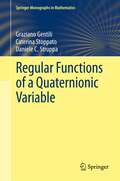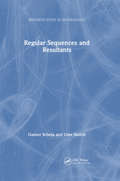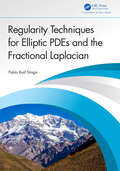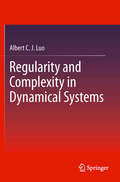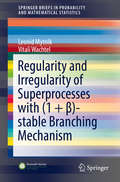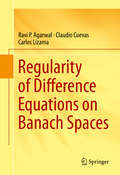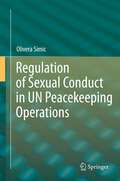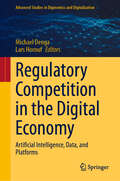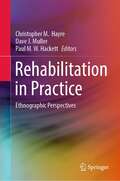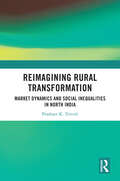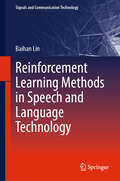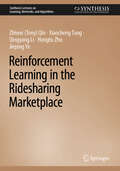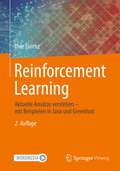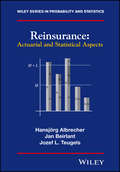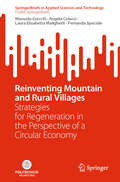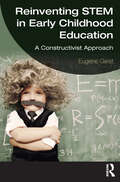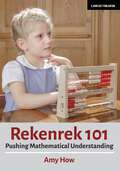- Table View
- List View
Regular Functions of a Quaternionic Variable
by Daniele C. Struppa Caterina Stoppato Graziano GentiliThe theory of slice regular functions over quaternions is the central subject of the present volume. This recent theory has expanded rapidly, producing a variety of new results that have caught the attention of the international research community. At the same time, the theory has already developed sturdy foundations. The richness of the theory of the holomorphic functions of one complex variable and its wide variety of applications are a strong motivation for the study of its analogs in higher dimensions. In this respect, the four-dimensional case is particularly interesting due to its relevance in physics and its algebraic properties, as the quaternion forms the only associative real division algebra with a finite dimension n>2. Among other interesting function theories introduced in the quaternionic setting, that of (slice) regular functions shows particularly appealing features. For instance, this class of functions naturally includes polynomials and power series. The zero set of a slice regular function has an interesting structure, strictly linked to a multiplicative operation, and it allows the study of singularities. Integral representation formulas enrich the theory and they are a fundamental tool for one of the applications, the construction of a noncommutative functional calculus. The volume presents a state-of-the-art survey of the theory and a brief overview of its generalizations and applications. It is intended for graduate students and researchers in complex or hypercomplex analysis and geometry, function theory, and functional analysis in general.
Regular Polytopes
by H. S. CoxeterPolytopes are geometrical figures bounded by portions of lines, planes, or hyperplanes. In plane (two dimensional) geometry, they are known as polygons and comprise such figures as triangles, squares, pentagons, etc. In solid (three dimensional) geometry they are known as polyhedra and include such figures as tetrahedra (a type of pyramid), cubes, icosahedra, and many more; the possibilities, in fact, are infinite! H. S. M. Coxeter's book is the foremost book available on regular polyhedra, incorporating not only the ancient Greek work on the subject, but also the vast amount of information that has been accumulated on them since, especially in the last hundred years. The author, professor of Mathematics, University of Toronto, has contributed much valuable work himself on polytopes and is a well-known authority on them. Professor Coxeter begins with the fundamental concepts of plane and solid geometry and then moves on to multi-dimensionality. Among the many subjects covered are Euler's formula, rotation groups, star-polyhedra, truncation, forms, vectors, coordinates, kaleidoscopes, Petrie polygons, sections and projections, and star-polytopes. Each chapter ends with a historical summary showing when and how the information contained therein was discovered. Numerous figures and examples and the author's lucid explanations also help to make the text readily comprehensible. Although the study of polytopes does have some practical applications to mineralogy, architecture, linear programming, and other areas, most people enjoy contemplating these figures simply because their symmetrical shapes have an aesthetic appeal. But whatever the reasons, anyone with an elementary knowledge of geometry and trigonometry will find this one of the best source books available on this fascinating study.
Regular Sequences and Resultants
by Uwe Storch Gunter SchejaThis carefully prepared manuscript presents elimination theory in weighted projective spaces over arbitrary noetherian commutative base rings. Elimination theory is a classical topic in commutative algebra and algebraic geometry, and it has become of renewed importance recently in the context of applied and computational algebra. This monograph pro
Regular and Irregular Holonomic D-Modules
by Masaki Kashiwara Pierre SchapiraD-module theory is essentially the algebraic study of systems of linear partial differential equations. This book, the first devoted specifically to holonomic D-modules, provides a unified treatment of both regular and irregular D-modules. The authors begin by recalling the main results of the theory of indsheaves and subanalytic sheaves, explaining in detail the operations on D-modules and their tempered holomorphic solutions. As an application, they obtain the Riemann–Hilbert correspondence for regular holonomic D-modules. In the second part of the book the authors do the same for the sheaf of enhanced tempered solutions of (not necessarily regular) holonomic D-modules. Originating from a series of lectures given at the Institut des Hautes Études Scientifiques in Paris, this book is addressed to graduate students and researchers familiar with the language of sheaves and D-modules, in the derived sense.
Regularity Techniques for Elliptic PDEs and the Fractional Laplacian
by Pablo Raúl StingaRegularity Techniques for Elliptic PDEs and the Fractional Laplacian presents important analytic and geometric techniques to prove regularity estimates for solutions to second order elliptic equations, both in divergence and nondivergence form, and to nonlocal equations driven by the fractional Laplacian. The emphasis is placed on ideas and the development of intuition, while at the same time being completely rigorous. The reader should keep in mind that this text is about how analysis can be applied to regularity estimates. Many methods are nonlinear in nature, but the focus is on linear equations without lower order terms, thus avoiding bulky computations. The philosophy underpinning the book is that ideas must be flushed out in the cleanest and simplest ways, showing all the details and always maintaining rigor. Features Self-contained treatment of the topic Bridges the gap between upper undergraduate textbooks and advanced monographs to offer a useful, accessible reference for students and researchers. Replete with useful references.
Regularity Theory for Mean-Field Game Systems
by Diogo A. Gomes Edgard A. Pimentel Vardan VoskanyanBeginning with a concise introduction to the theory of mean-field games (MFGs), this book presents the key elements of the regularity theory for MFGs. It then introduces a series of techniques for well-posedness in the context of mean-field problems, including stationary and time-dependent MFGs, subquadratic and superquadratic MFG formulations, and distinct classes of mean-field couplings. It also explores stationary and time-dependent MFGs through a series of a-priori estimates for solutions of the Hamilton-Jacobi and Fokker-Planck equation. It shows sophisticated a-priori systems derived using a range of analytical techniques, and builds on previous results to explain classical solutions. The final chapter discusses the potential applications, models and natural extensions of MFGs. As MFGs connect common problems in pure mathematics, engineering, economics and data management, this book is a valuable resource for researchers and graduate students in these fields.
Regularity and Complexity in Dynamical Systems
by Albert C. LuoRegularity and Complexity in Dynamical Systems describes periodic and chaotic behaviors in dynamical systems, including continuous, discrete, impulsive, discontinuous, and switching systems. In traditional analysis, the periodic and chaotic behaviors in continuous, nonlinear dynamical systems were extensively discussed even if unsolved. In recent years, there has been an increasing amount of interest in periodic and chaotic behaviors in discontinuous dynamical systems because such dynamical systems are prevalent in engineering. Usually, the smoothening of discontinuous dynamical system is adopted in order to use the theory of continuous dynamical systems. However, such technique cannot provide suitable results in such discontinuous systems. In this book, an alternative way is presented to discuss the periodic and chaotic behaviors in discontinuous dynamical systems.
Regularity and Irregularity of Superprocesses with (1 + β)-stable Branching Mechanism
by Leonid Mytnik Vitali WachtelThis is the only book discussing multifractal properties of densities of stable superprocesses, containing latest achievements while also giving the reader a comprehensive picture of the state of the art in this area. It is a self-contained presentation of regularity properties of stable superprocesses and proofs of main results and can serve as an introductory text for a graduate course. There are many heuristic explanations of technically involved results and proofs and the reader can get a clear intuitive picture behind the results and techniques.
Regularity and Stochasticity of Nonlinear Dynamical Systems
by Dimitri Volchenkov Xavier LeonciniThis book presents recent developments in nonlinear dynamics and physics with an emphasis on complex systems. The contributors provide recent theoretic developments and new techniques to solve nonlinear dynamical systems and help readers understand complexity, stochasticity, and regularity in nonlinear dynamical systems. This book covers integro-differential equation solvability, Poincare recurrences in ergodic systems, orientable horseshoe structure, analytical routes of periodic motions to chaos, grazing on impulsive differential equations, from chaos to order in coupled oscillators, and differential-invariant solutions for automorphic systems, inequality under uncertainty.
Regularity of Difference Equations on Banach Spaces
by Ravi P. Agarwal Claudio Cuevas Carlos LizamaThis work introduces readers to the topic of maximal regularity for difference equations. The authors systematically present the method of maximal regularity, outlining basic linear difference equations along with relevant results. They address recent advances in the field, as well as basic semi group and cosine operator theories in the discrete setting. The authors also identify some open problems that readers may wish to take up for further research. This book is intended for graduate students and researchers in the area of difference equations, particularly those with advance knowledge of and interest in functional analysis.
Regulation of Sexual Conduct in UN Peacekeeping Operations
by Olivera SimicThis book critically examines the response of the United Nations (UN) to the problem of sexual exploitation in UN Peace Support Operations. It assesses the Secretary-General's Bulletin on Special Protection from Sexual Exploitation and Sexual Abuse (2003) (SGB) and its definition of sexual exploitation, which includes sexual relationships and prostitution. With reference to people affected by the policy (using the example of Bosnian women and UN peacekeepers), and taking account of both radical and 'sex positive' feminist perspectives, the book finds that the inclusion of consensual sexual relationships and prostitution in the definition of sexual exploitation is not tenable. The book argues that the SGB is overprotective, relies on negative gender and imperial stereotypes, and is out of step with international human rights norms and gender equality. It concludes that the SGB must be revised in consultation with those affected by it, namely local women and peacekeepers, and must fully respect their human rights and freedoms, particularly the right to privacy and sexuality rights.
Regulatory Competition in the Digital Economy: Artificial Intelligence, Data, and Platforms (Advanced Studies in Diginomics and Digitalization)
by Lars Hornuf Michael DengaThe digital economy is reinvigorating regulatory competition, yet little is known about which rules and jurisdictions can effectively bind companies nor what competitive motivations underlie certain rules. In addition to purely economic motives, legislators are now also driving the pursuit of digital sovereignty and the enforcement of social values in digital spaces. It also remains unclear what regulatory weight the self-regulation of private companies has in multi-level governance systems. This book examines regulatory competition in the three main pillars of digital markets: artificial intelligence, data, and platforms. It brings together legal scholars, economists and information systems experts, providing relevant examples and structured analysis of the aims and outcomes of regulatory competition in the digital economy. “A timely exploration of the balancing acts regulators must perform to manage private power in a globalized digital economy. Essential for understanding the intersection of law, economics, and technology in the contemporary digital ecosystem.” Jens Frankenreiter, Associate Professor of Law, Washington University “The book by Denga and Hornuf provides a comprehensive and timely exploration of the intricate regulatory challenges posed by big data, artificial intelligence, and platforms in the Digital Single Market. If offers critical insights for policymakers, scholars, and businesses navigating this evolving landscape.” Philipp Hacker, Professor for Law and Ethics of the Digital Society, European University Viadrin “Artificial Intelligence is fundamentally disrupting how we enable economic growth and how we regulate fair competition. Luckily, Denga and Hornuf provide a detailed and comprehensive overview of the thorniest and most complex regulatory issues while at the same time offering thoughtful and feasible solutions. "Regulatory Competition in the Digital Economy" is a treasure trove for anyone interested in market regulation, fair competition, consumer protection, and geopolitical questions.” Sandra Wachter, Professor of Technology and Regulation, Oxford Internet Institute
Regulierung von Künstlicher Intelligenz in der EU: Praxisbezogene Lösungsansätze für die Sicherheit von KI-Anwendungen (Vertrauenswürdige KI)
by Rainer Bernnat Jordan PötschDieses Buch bietet eine praxisorientierte Einführung in die Regulierung von Künstlicher Intelligenz (KI) in der EU. Es vereint theoretisches Wissen mit konkreten Handlungsempfehlungen zur Umsetzung von KI-Standards und Gesetzen, insbesondere im Rahmen des EU AI Acts. Durch eine speziell entwickelte Systematik werden KI-relevante Gesetze und Standards systematisch erfasst und bewertet. Führungskräfte, CISOs und Cybersecurity-Experten erhalten wertvolle Einblicke, wie sie die Vertrauenswürdigkeit von KI-Systemen in ihren Organisationen gewährleisten können. Ein besonderer Schwerpunkt liegt auf der Integration von KI in bestehende Sicherheitsstrukturen sowie der Nutzung bewährter Frameworks.
Rehabilitation in Practice: Ethnographic Perspectives
by Paul M. W. Hackett Christopher M. Hayre Dave J. MullerThis book focuses on developing the use of ethnographic research for rehabilitation practitioners by recognizing its value methodologically and empirically in the field of rehabilitation. The very nature of ethnographic research offers an array of opportunities for researchers to understand the social world around them. The book identifies the multifaceted use of ethnographic methods in the rehabilitation setting. It touches on how acute and chronic conditions can affect the nature of ethnographic work in attempts to offer originality in a range of rehabilitation settings. Readers will find this collection of examples useful for informing their own research, and it aims to enlighten new discussion and arguments regarding both methodological and empirical use of ethnographic work internationally.
Reimagining Rural Transformation: Market Dynamics and Social Inequalities in North India
by Prashant K TrivediThis book examines the effects of the pattern of growing integration between the rural and urban economies in India. Drawing on in-depth surveys conducted in villages in north India, it examines the rural agricultural economy's transformation, productivity, technology deployment, and social relations over a period of seven years. The book focuses on the socially embedded nature of the dynamics of transformation, weaving analysis around the axis of land, caste, and gender. It also identifies policy gaps and recommends steps for a sustainable and inclusive rural transformation in the Global South.An important contribution to the study of India’s economic and social landscape, this book will be useful for scholars of agriculture, sociology, economics, political science, development studies, and South Asian studies. It will also be of interest to policymakers and journalists interested in rural development, migration, employment, agriculture, and demography.
Reinforcement Learning Methods in Speech and Language Technology (Signals and Communication Technology)
by Baihan LinThis book offers a comprehensive guide to reinforcement learning (RL) and bandits methods, specifically tailored for advancements in speech and language technology. Starting with a foundational overview of RL and bandit methods, the book dives into their practical applications across a wide array of speech and language tasks. Readers will gain insights into how these methods shape solutions in automatic speech recognition (ASR), speaker recognition, diarization, spoken and natural language understanding (SLU/NLU), text-to-speech (TTS) synthesis, natural language generation (NLG), and conversational recommendation systems (CRS). Further, the book delves into cutting-edge developments in large language models (LLMs) and discusses the latest strategies in RL, highlighting the emerging fields of multi-agent systems and transfer learning. Emphasizing real-world applications, the book provides clear, step-by-step guidance on employing RL and bandit methods to address challenges in speech and language technology. It includes case studies and practical tips that equip readers to apply these methods to their own projects. As a timely and crucial resource, this book is ideal for speech and language researchers, engineers, students, and practitioners eager to enhance the performance of speech and language systems and to innovate with new interactive learning paradigms from an interface design perspective.
Reinforcement Learning for Optimal Feedback Control: A Lyapunov-based Approach (Communications and Control Engineering)
by Patrick Walters Joel Rosenfeld Rushikesh Kamalapurkar Warren DixonReinforcement Learning for Optimal Feedback Control develops model-based and data-driven reinforcement learning methods for solving optimal control problems in nonlinear deterministic dynamical systems. In order to achieve learning under uncertainty, data-driven methods for identifying system models in real-time are also developed. The book illustrates the advantages gained from the use of a model and the use of previous experience in the form of recorded data through simulations and experiments. The book’s focus on deterministic systems allows for an in-depth Lyapunov-based analysis of the performance of the methods described during the learning phase and during execution. To yield an approximate optimal controller, the authors focus on theories and methods that fall under the umbrella of actor–critic methods for machine learning. They concentrate on establishing stability during the learning phase and the execution phase, and adaptive model-based and data-driven reinforcement learning, to assist readers in the learning process, which typically relies on instantaneous input-output measurements. This monograph provides academic researchers with backgrounds in diverse disciplines from aerospace engineering to computer science, who are interested in optimal reinforcement learning functional analysis and functional approximation theory, with a good introduction to the use of model-based methods. The thorough treatment of an advanced treatment to control will also interest practitioners working in the chemical-process and power-supply industry.
Reinforcement Learning for Reconfigurable Intelligent Surfaces: Assisted Wireless Communication Systems (SpringerBriefs in Computer Science)
by Octavia A. Dobre Alice Faisal Ibrahim Al-Nahhal Telex M. NgatchedThis book presents the intersection of two dynamic fields: Reinforcement Learning (RL) and RIS- Assisted Wireless Communications. With an emphasis on both discrete and continuous problems, it introduces a comprehensive overview of RL techniques and their applications in the evolving world of RIS-assisted wireless communications. Chapter 1 introduces the fundamentals of RL and deep RL (DRL), providing a solid foundation for understanding subsequent chapters. It also presents the Q-learning, deep Q-learning, and deep deterministic policy gradient algorithms. Chapter 2 provides a holistic overview of RIS-assisted systems and details several use cases in wireless communications. Then, Chapters 3 and 4 present various applications of the discrete and continuous DRL to RIS-assisted wireless communications. From maximizing the sum-rate to minimizing, the system resources and maximizing the energy efficiency. These chapters showcase the versatility of the DRL algorithms in tackling arange of challenges. This book concludes with Chapter 5, which introduces the challenges and future directions in this field. It explores the particulars of hyperparameter tuning, problem design, and complexity analysis, while also highlighting the potential of hybrid DRL, multi-agent DRL, and transfer learning techniques for advancing wireless communication systems. Optimizing RIS-Assisted Wireless Systems requires powerful algorithms to cope with the dynamic propagation environment. DRL is envisioned as one of the key enabling techniques to exploit the full potential of RIS-Assisted Wireless Communication Systems. It empowers these systems to intelligently adapt to dynamic wireless environments, maximize performance metrics, and adjusts their configurations to accommodate diverse use cases efficiently. This book serves as a valuable resource, shedding light on the potential of DRL to optimize RIS-Assisted Wireless Communication, enabling researchers, engineers, advanced level students in computer science and electrical engineering and enthusiasts to grasp the intricacies of this topic. It offers a comprehensive understanding of the principles, applications, and challenges, making it a reference to recognize the full potential of the RIS technology in modern wireless communication systems.
Reinforcement Learning in the Ridesharing Marketplace (Synthesis Lectures on Learning, Networks, and Algorithms)
by Hongtu Zhu Jieping Ye Zhiwei (Tony) Qin Xiaocheng Tang Qingyang LiThis book provides a comprehensive overview of reinforcement learning for ridesharing applications. The authors first lay out the fundamentals of the ridesharing system architectures and review the basics of reinforcement learning, including the major applicable algorithms. The book describes the research problems associated with the various aspects of a ridesharing system and discusses the existing reinforcement learning approaches for solving them. The authors survey the existing research on each problem, and then examine specific case studies. The book also includes a review of two of methods closely related to reinforcement learning: approximate dynamic programming and model-predictive control.
Reinforcement Learning: Aktuelle Ansätze verstehen – mit Beispielen in Java und Greenfoot
by Uwe LorenzIn uralten Spielen wie Schach oder Go können sich die brillantesten Spieler verbessern, indem sie die von einer Maschine produzierten Strategien studieren. Robotische Systeme üben ihre Bewegungen selbst. In Arcade Games erreichen lernfähige Agenten innerhalb weniger Stunden übermenschliches Niveau. Wie funktionieren diese spektakulären Algorithmen des bestärkenden Lernens? Mit gut verständlichen Erklärungen und übersichtlichen Beispielen in Java und Greenfoot können Sie sich die Prinzipien des bestärkenden Lernens aneignen und in eigenen intelligenten Agenten anwenden. Greenfoot (M.Kölling, King’s College London) und das Hamster-Modell (D.Bohles, Universität Oldenburg) sind einfache, aber auch mächtige didaktische Werkzeuge, die entwickelt wurden, um Grundkonzepte der Programmierung zu vermitteln. Wir werden Figuren wie den Java-Hamster zu lernfähigen Agenten machen, die eigenständig ihre Umgebung erkunden. Die zweite Auflage enthält neue Themen wie "Genetische Algorithmen" und "Künstliche Neugier" sowie Korrekturen und Überarbeitungen.
Reinsurance: Actuarial and Statistical Aspects
by Hansjöerg Albrecher Jan Beirlant Jozef L. TeugelsReinsurance: Actuarial and Statistical Aspects provides a survey of both the academic literature in the field as well as challenges appearing in reinsurance practice and puts the two in perspective. The book is written for researchers with an interest in reinsurance problems, for graduate students with a basic knowledge of probability and statistics as well as for reinsurance practitioners. The focus of the book is on modelling together with the statistical challenges that go along with it. The discussed statistical approaches are illustrated alongside six case studies of insurance loss data sets, ranging from MTPL over fire to storm and flood loss data. Some of the presented material also contains new results that have not yet been published in the research literature. An extensive bibliography provides readers with links for further study.
Reinventing Mountain and Rural Villages: Strategies for Regeneration in the Perspective of a Circular Economy (SpringerBriefs in Applied Sciences and Technology)
by Angela Colucci Manuela Grecchi Laura Elisabetta Malighetti Fernanda SpecialeThis book explores problems generated by the abandonment of mountain villages, which also represented strategic sites for guarding against environmental hazards, and proposes a process of regeneration and upgrade of the built environment, with a view to a circular economy and social and economic development. It provides principles, methods, and tools supporting the design and management of the regeneration of abandoned mountain/rural villages and presents the transferable results of multidisciplinary applied research involving several local contexts and compares methodological and technical design solutions developed in successful practices. The book consists of six chapters that address specific issues in the regeneration process of depopulated mountain villages.
Reinventing STEM in Early Childhood Education: A Constructivist Approach
by Eugene GeistTeaching STEM to young children is about more than helping them learn their numbers and facts. It is an important and complex process that, to be effective, should honor the way children’s brains are developing. This book outlines how early childhood educators can best support young children’s STEM journeys as children naturally take in information about their environment, synthesize it, and grow in the process. This comprehensive text details different theories of learning; research on how young brains develop; practical information on preparing your environment and yourself for teaching STEM to children; guidance for supporting diverse populations of students; and developmental guidelines, sample standards, resources, and lesson plans. Organized chronologically, the book connects relevant STEM topics with each developmental age range and outlines common school standards for each grade. Reinventing STEM in Early Childhood Education is meant to be a core text for preservice teachers in math and science methods courses and is also important reading for teacher educators and professional development programs.
Rekenek 101: Pushing Mathematical Understanding
by Amy HowDesigned and developed by a mathematic curriculum researcher at the Freudenthal Institute at Utrecht University, the rekenrek is an exciting and innovative classroom tool that enhances and supports the natural development of number sense in children. It encourages learning across a range of mathematical skills and concepts, from simple addition and subitization to commutativity, distributive property and fractions. However, despite the potential and versatility of this manipulative, there has been surprisingly little written about either its application or its benefits - until now.When the stacks of rekenreks first arrived at Amy How's school, she was tasked with discovering and explaining their function to the rest of the staff - despite the scarcity of current research or other information. Over the six years since, she has developed her own set of tasks and strategies, which she regularly presents to teachers around the world. These techniques – effective, straightforward and very popular – are the basis of this book. Rekenrek 101 is written in a format that makes for a useful teacher resource: not too long; clear, concise and inspiring enough for readers to try the new ideas the next day in class. It is easy to follow and easy to navigate while demonstrating a simple change in practice that stays up with current trends. This is not a book on theory, but it is based on what the latest research is telling us.
Rekenrek 101: Pushing Mathematical Understanding
by Amy HowDesigned and developed by a mathematic curriculum researcher at the Freudenthal Institute at Utrecht University, the rekenrek is an exciting and innovative classroom tool that enhances and supports the natural development of number sense in children. It encourages learning across a range of mathematical skills and concepts, from simple addition and subitization to commutativity, distributive property and fractions. However, despite the potential and versatility of this manipulative, there has been surprisingly little written about either its application or its benefits - until now.When the stacks of rekenreks first arrived at Amy How's school, she was tasked with discovering and explaining their function to the rest of the staff - despite the scarcity of current research or other information. Over the six years since, she has developed her own set of tasks and strategies, which she regularly presents to teachers around the world. These techniques – effective, straightforward and very popular – are the basis of this book. Rekenrek 101 is written in a format that makes for a useful teacher resource: not too long; clear, concise and inspiring enough for readers to try the new ideas the next day in class. It is easy to follow and easy to navigate while demonstrating a simple change in practice that stays up with current trends. This is not a book on theory, but it is based on what the latest research is telling us.
